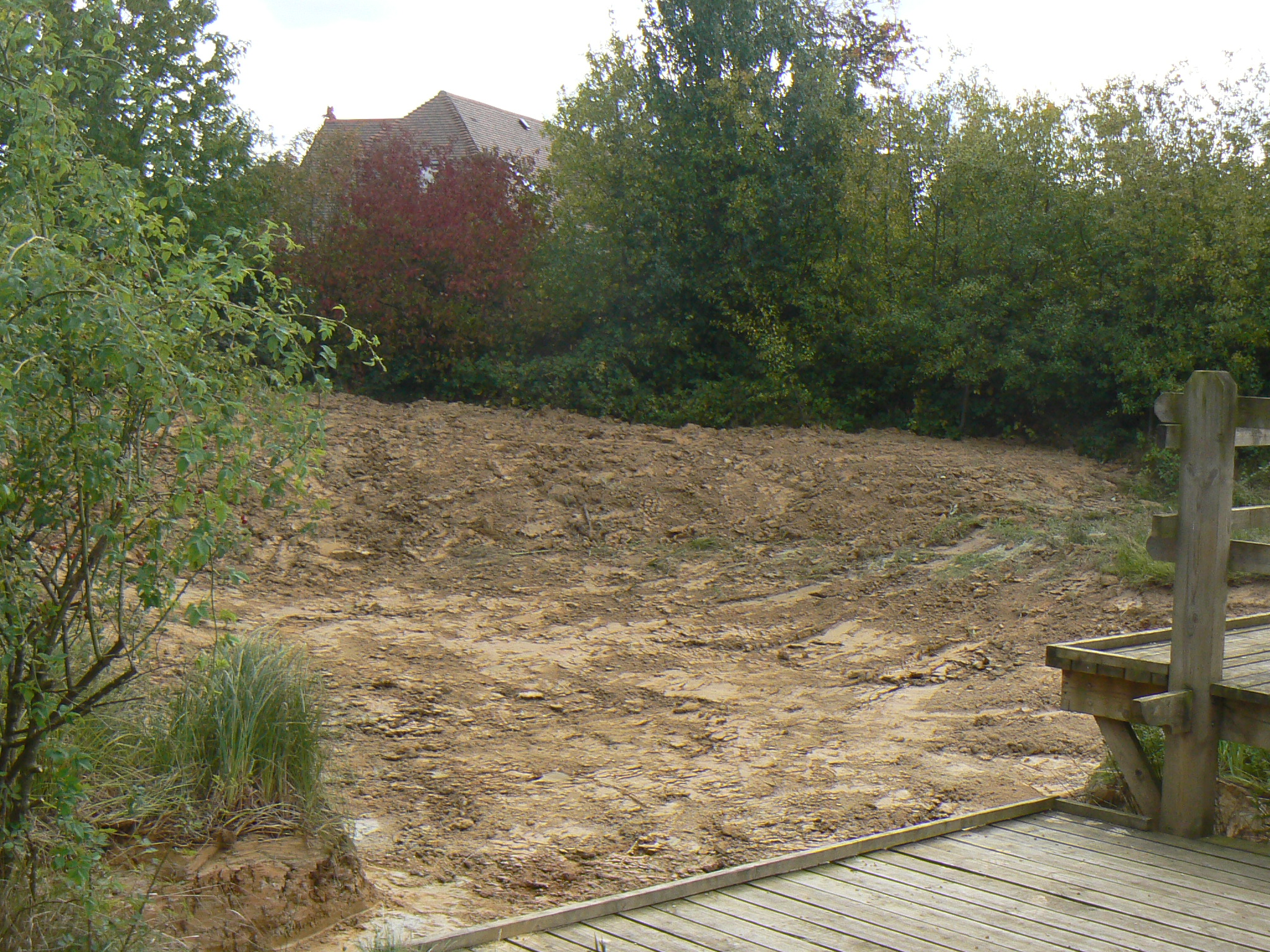Hedge Laying (added October 2012)
Not sure if people would generally have much knowledge about the traditional art of hedge-laying, but I thought I would give some background, given that we have just laid the hedge between Jenner's field and Beacon Field - well, at time of writing, it is actually 50% complete - it's quite an involved task and the 2nd half is due to be undertaken on Sat Oct 20th.
The original purpose of hedges was mainly to keep livestock in their place, and therefore it is important for hedges to be sufficiently dense at ground level to act as an effective stock-proof boundary, which coincidently is just the sort of conditions favoured by many other species such as nesting birds.
Unfortunately, it is the case that a hedge that is just planted and left to develop naturally will soon start to get thin and 'leggy' at the lower levels, as the closely-planted trees try to out-compete each other and grow upwards in search of maximum sunlight, so the solution is to 'lay' them, which creates a much more dense barrier at low-level, as well as encouraging the plants to grow from down at the ground again. I will attach some 'before' and 'after' photographs to this article, which will clearly illustrate what can be achieved.
First thing to do is to clear away a lot of the foliage, so as to expose the bare stems of the hedge-plants, which are then partially cut through at an oblique angle just above ground level. The stem is then laid to one side (pleached) but still remains connected via bark and sapwood to the rootstock, so will remain alive despite being bent over at an angle. Any awkward side branches are then cut away and the whole process repeated with the pleached stems laying on top of one another to form a dense, neat barrier. To add further strength, vertical stakes are put in the ground at intervals and these stakes further bound together with horizontal 'heatherings' to create a rigid structure.
Hedge laying traditionally takes place in the colder months when the plants are most dormant, but it is in the following spring when the real magic starts to occur. As the plants in the laid hedge start to come back to life, they will generate new shoots from the laid over pleaches and, most importantly, from around the original sloping pleach-cut, so almost behaving like a sort of coppice, with strong new growth coming up from ground level to further reinforce the structure.
With some species of hedge plants, laying is quite a long-term project, and further management doesn't need to be undertaken for maybe 50-75 years, but unfortunately our hedges are usually made of Hazel, which does form a good hedge, but needs more frequent management, so it will probably be necessary to repeat the whole process in perhaps 10-20 years, but it is fascinating to watch this traditional country skill being carried out.
'Before' - Note that hedge is very thin and patchy down at ground level
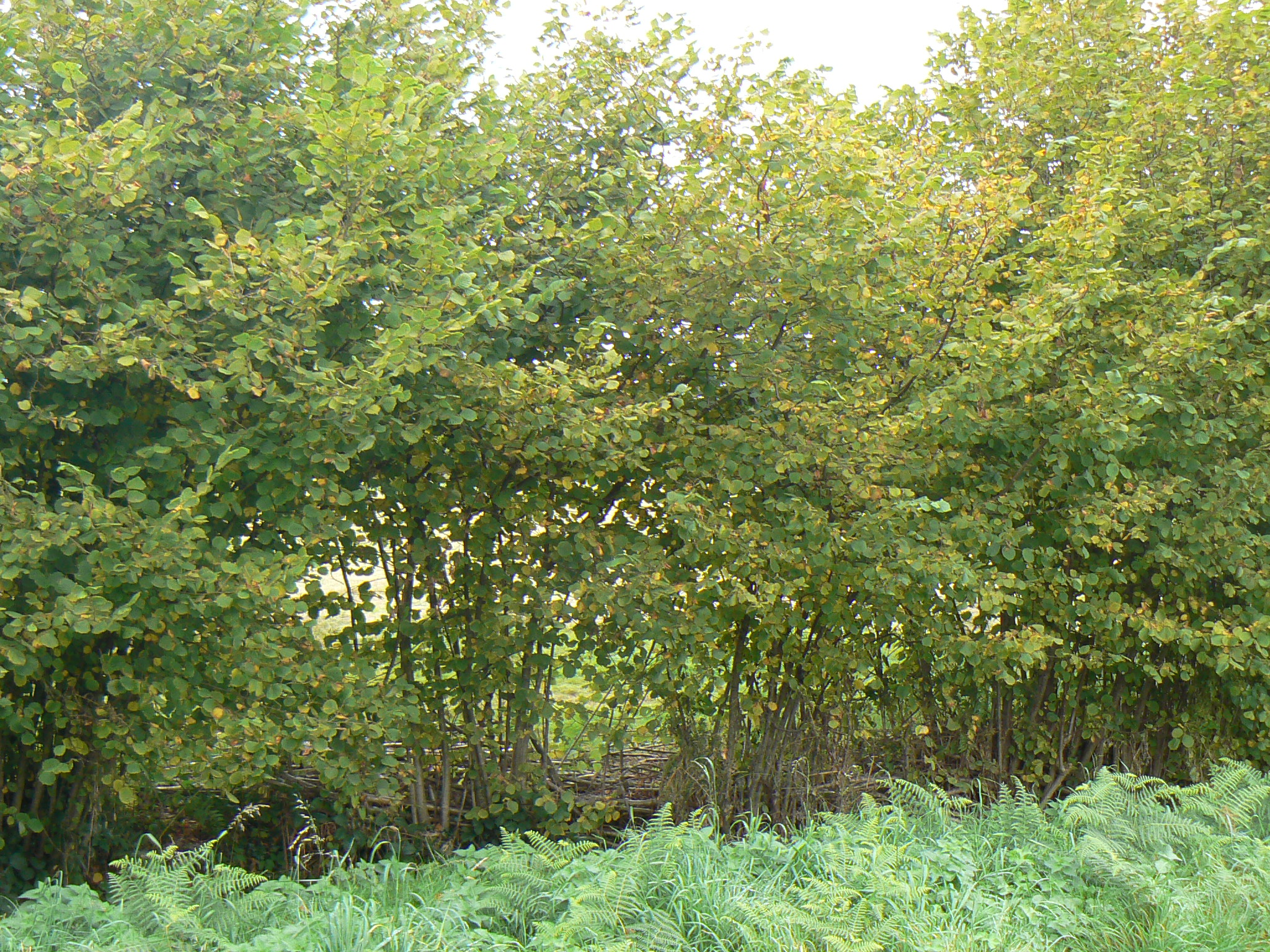
'After' - a neat, thick barrier which will grow vigorously from ground level in subsequent years. The support stakes and bindings can clearly be seen.
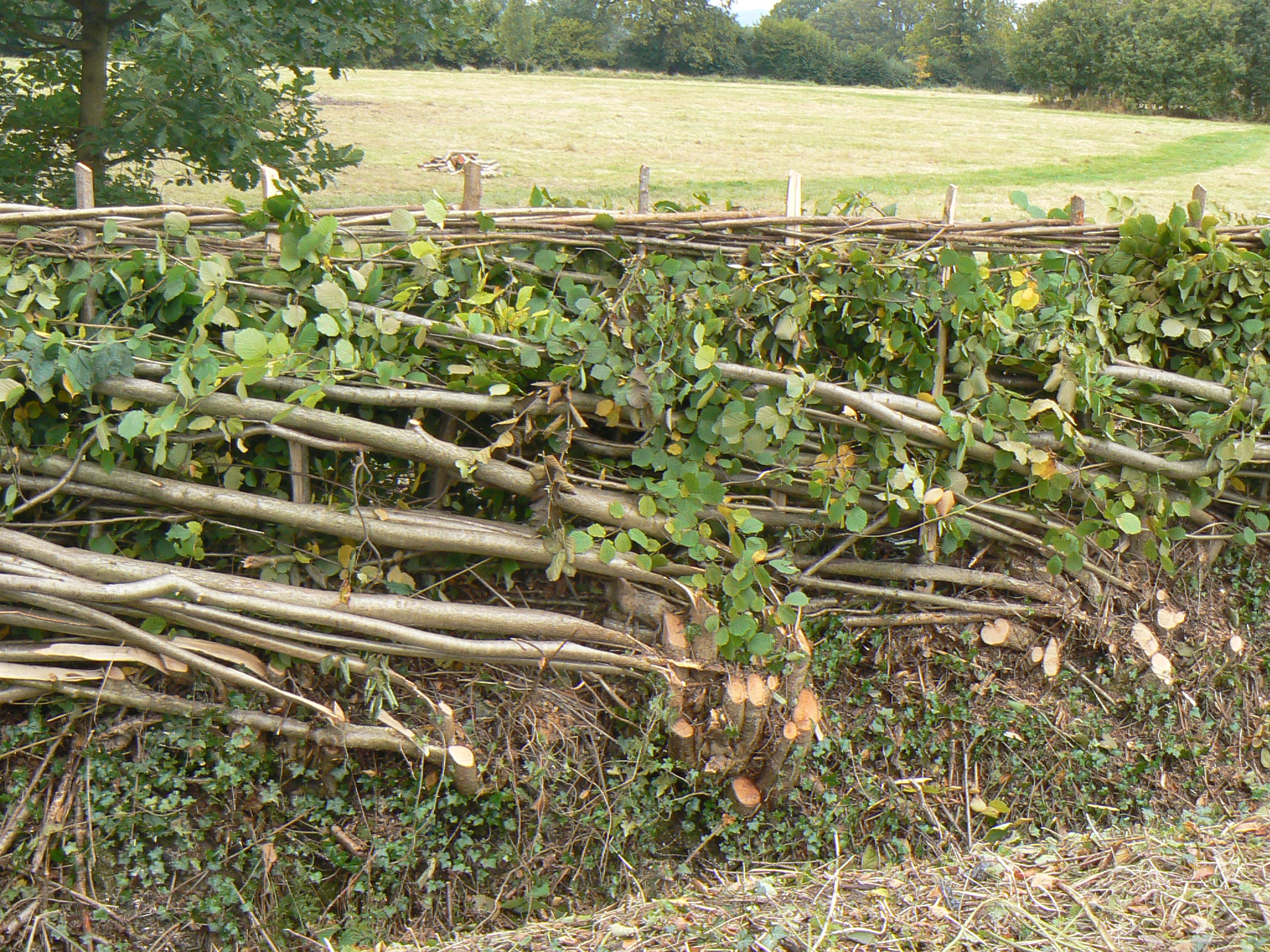
Pond Dipping 2012 (added September 2012)
The last of our scheduled pond-dipping events was held on September 16th, and I guess now is probably a good time to take stock of what we achieved in 2012.
First thing to say is that the overall health of the ponds seems very good. Only a year ago, the main pond had to be completely re-dug and 12 months ago it was completely empty of water (although not residual life, you might suspect) and yet now it is looking well established and hosts a wide variety of flora and fauna. Helped by a very rainy Spring and early Summer, we have had plenty of water-depth throughout the entire year and have managed to hold a full programme of pond-dipping, and even now, after a pretty dry couple of months, there is roughly 1metre of water depth, so I think we can count the maintenance work as a success.
One of the tips that we received when visited last year by an expert on dragonflies, was that many dragonfly species favour a significant proportion of open water (as opposed to vegetation) and so I assume that the remodelled main pond will be much to their liking - in Summer 2011, it was not much more than a damp puddle! In any event, dragonfly sightings have been numerous this year, and we have recorded 4 new species on the reserve, although in fairness, this possibly owes as much to greater interest and vigilance on our part than the fact that we have actually attracted in new dragonflies.
This year, we have been keeping a careful note of what we have caught during the pond-dipping sessions and it has been very interesting to see how the catch has varied between the 2 ponds and also how it has changed as the seasons have progressed. Fair to say, that some things we have observed seem quite logical andÂÂÂ understandable, but others less so.... For example, I am quite surprised that we still seem to have large numbers of relatively tiny newt larvae in the ponds - I would have expected them to be much more developed by now if they are to survive their first Winter. I believe it is the case though, that sometimes the baby newts will spend their first Winter within the pond, so maybe these later developers will do that.
It has been quite surprising just how quickly the 'new' main pond has been populated with creatures - for example, we have caught roughly 4 times as many Great Crested Newts from the main pond as compared to the upper pond - and I was quite surprised to find that we are actually catching what appears to be quite well-developed large dragonfly larvae from the main pond, when it has only had water in it for a single season. Notwithstanding these exceptions though, it is the case that, generally speaking, the catch from the undisturbed upper pond has been larger and more varied than our re-modelled main pond, but you might expect this to change next year, as the new pond settles down and matures.
Have a look at the details of our catch under the 'Surveys' page and you can perhaps draw your own conclusions.
Autumn Events 2012 (added August 2012)
We warmly invite you to join us to help children plant bulbs in the Community Orchard on Sunday, October 7th - 2 pm - 4 pm. This will give more early nectar for our struggling bees. Having acquired sweeping nets, the planting session will also include a Mini-Beast Hunt, for which new nets will be available.
Then our annual National Tree Week Work Party on Sunday, November 25th 10am–1 pm.
We have some beautiful new specimen trees to plant; a Weeping ash, Holm oak, Crab apples and a small section of fruiting hedge. These provide a good habitat for pollinating insects. We shall also replace the Downy birch and add more gorse bays to encourage linnets and other birds. Then there is urgent hedge work to be done down at the pond, and building the bonfires.
Pond Dipping June 17th (added June 2012)
Another good pond-dipping session was held, the weather was fine and we mainly spent our time in the warm sunshine. Not too many children turned up, but (don't know if it's the influence of Springwatch!) but we had quite a few adults turned up to have a go, without actually bringing any children with them! Also, because there were less youngsters to be supervised and assisted, it enabled some of the helpers to have a good go themselves (me included!) so we ended up having a nice time and had a good catch.
It is fascinating to see the way the catch is changing as the year progresses, and this was never more graphically illustrated than by the newts that we found.... In the first 2 sessions earlier this year, we caught loads of adults of both Great Crested and Smooth newt species, but this time only 3 in total and none at all from the main pond - I had noticed when looking around the ponds earlier in the day that there seemed to be very few newts on display, and I had been speculating whether this is because they have now completed their breeding cycle and had now started to haul up out of the water. In any event, what we lacked in adults, we made up for in young efts, and we pulled out 90 and it was fascinating to see the differences in size and proportions between the 2 species, but also presumably some that were a little older than others.
In a (partly unintentional!) development, we also caught our first frog tadpoles and one quite well-developed froglet. This is very good news, as no-one could remember any frogs having successfully bred in the pond area before (thought to be due to the high newt numbers) so it was good that our new scrapes have proved effective in their first year. It's not quite 'mission accomplished' for the frogs this year though, as now that they are on land, they will have an additional range of predators that are queue-ing up to have them for lunch, notably birds. We did find some other froglets though, and they seemed to be mainly under the bridge between the scrapes and the upper pond, so hopefully will be afforded some protection there.
In other developments, we caught very few dragonfly/damselfly larvae and no caddisfly larvae at all, and we speculate that they have mainly all hatched out for this year.
What we did catch though was (what we learned to be!) a Hair Worm. As the name suggests, this looks very much like a human hair, was perhaps 12-15cm long and, it was only when it started to wriggle about, that we discovered it to be alive at all! Something that none of us had ever seen before anyway, and due to a rush of blood to the head, I cunningly failed to get a photograph before we set it free.
The water in the main pond is starting to clear slightly, but we need to build up more of a base of vegetation, as it is still largely just bare clay, and the 'catch' is relatively low as a result. I imagine that it won't take long for nature to fill this vacuum, particularly as water is flowing freely between the ponds now, so seeds, spores etc will probably migrate from the upper pond in addition to plants that just find their own way and just re-establish from the seed bank. The large clay bank is now full of sprouting grass and many promising-looking seedlings - we have scattered quite a bit of seed about since last autumn and it is now starting to come good.
Oaken Wood (added June 2012)
A couple of weeks ago, I visited the Surrey branch reserve for UK Butterfly Conservation and have been asked to write up a trip report for inclusion into their magazine. This is currently in to press, but I thought you might be interested in an advanced copy of my report regarding what I saw - it's a great place to visit and less than an hour from here. If anyone needs any info, please e-mail me.....
A Field Trip to Oaken Wood – by Ray Baker
Never having seen a Wood White butterfly before – well, it is the UK’s rarest white butterfly – I had been looking forward to the field trip to the Oaken Wood reserve in early May, and it was therefore with some considerable disappointment when the weather was completely unsuitable to go ahead on the planned date. I was determined though, and therefore together with a friend Brian Thomas, decided to mount our own trip on May 25th, by which time the weather was far more suitable for butterflies.
I’d not been to the reserve before, so contacted Malcolm Bridge and he kindly supplied me with some good gen to help find the best places.
We arrived at 11:30, and it was already over 20c, sunny with only a light breeze, and we walked the short access track and turned right into the reserve proper just by the information board. Initially things were looking a bit quiet – we did see a couple of Small Whites and both male and female Brimstones, but not as many butterflies as you might have expected in the sunny clearings which looked just about perfect – maybe it was a bit early.
Continuing around the reserve, we found the small pond which had quite a few damselflies buzzing around – mainly Large Reds from what we could see, and a bit further on we came across our first Orange Tip. We were to see several more of this species throughout the day – all females, interestingly enough.
Having had a cursory look around much of the reserve, we decided to follow Malcolm’s directions and head out to Triangle Meadow (this involves continuing along the main access track past the reserve, L at the first T-junction, R at the second, and Triangle Meadow is just off to the right after about ½ mile or so) and things immediately started to improve.
First thing to catch our eye was an orange/brown butterfly, but it was ‘only’ a Comma – still nice to see though – but then an interesting looking small white was making its way along the wildflowers alongside the path edge. It was small and delicate looking – significantly smaller than the Brimstones and Orange Tips that we were now seeing quite a few of – and had a quite distinctive flight jizz, very fluttery, low to the ground but not travelling very fast. What was needed though was for it to settle (we learnt throughout the day that Wood Whites don’t settle very often!) so that we could confirm our suspicions, and eventually it did, enabling us to get a good view of the oval-shaped wing and smoky grey/green underwing which are characteristic of this species.
It was already quite hot, but as the temperature rose further over the next few hours, we started seeing more and more Wood Whites and, by the time we had walked to the triangle and back, we thought we had seen probably 30-40, which was excellent.
Once we got to Triangle Meadow, we were also able to see some different species and added 2-3 each of Dingy and Grizzled Skippers to the day-list, and then finally just by the ‘right turn’ T-junction we saw another orange butterfly which turned out to be a Pearl-bordered Fritillary, which we had been hoping for, but not with any great expectation, as we were unsure of the status of this species in Oaken Wood. Not being overly-familiar with eitherÂÂÂ Pearl-bordered or Small Pearl-bordered Fritillaries, I did a bit of research on the field marks and the salient features can be seen on the underwing of my photograph (back cover)
What makes this a P-b Fritillary is the fact that there are only 2 white/silver spots towards the front of the rear wing, the dark spot between them is quite small and edged with pale colour, and the edging of the 7 lunules which give the Pearl-bordered its name is red. TheÂÂÂ equivalent marks in Small P-b F are: several silver spots and a large all-dark spot near the front, and the 7 pearls are edged with black.
Not only was it good for butterflies, but we also enjoyed some other creatures too. Birds were very much in evidence and we estimated that we heard 6-8 Nightingales and we were very interested that they seem to favour completely different habitat as compared to our home-patch in east Surrey, where they only use thick thorn scrub, preferably near to running water, but in Oaken Wood we heard them singing from coppice, brambles and even once from a plantation of young conifers! We were also pleased to hear several Willow Warblers and a Cuckoo – both species which are increasingly hard to find around our way.
We are also interested in dragonflies, and noted both male and female Broad-bodied Chasers emerging from a ditch by the 2nd T-junction, and then came across a medium-sized, slim, yellowish dragonfly that we weren’t familiar with – a bit of research later on and we found it to be a Black-tailed Skimmer – so that was good too!
All in all, we thoroughly enjoyed our trip to Oaken Wood – it’s a great little reserve in a wider area of very interesting countryside.
Wood White
Pearl-bordered Fritillary
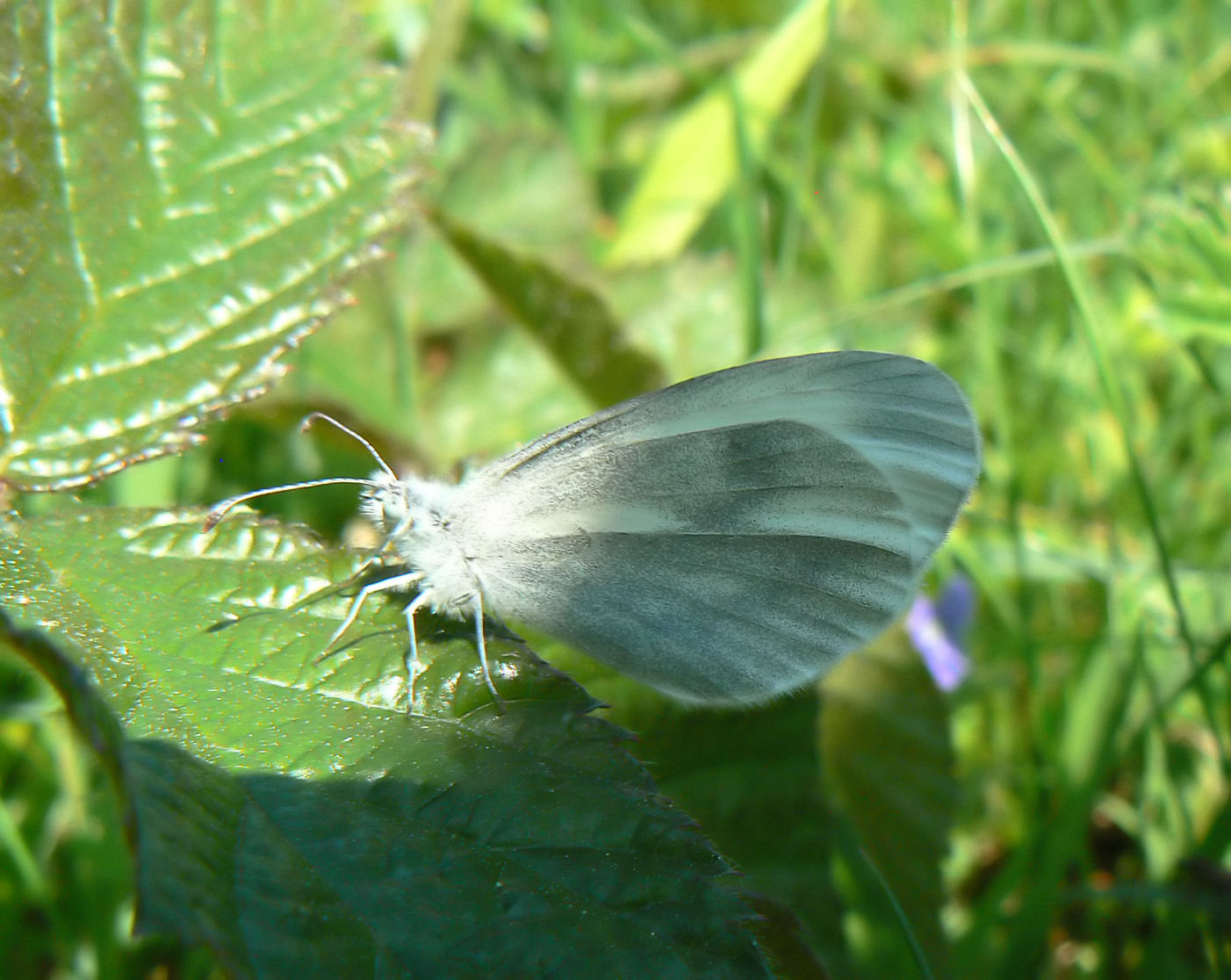
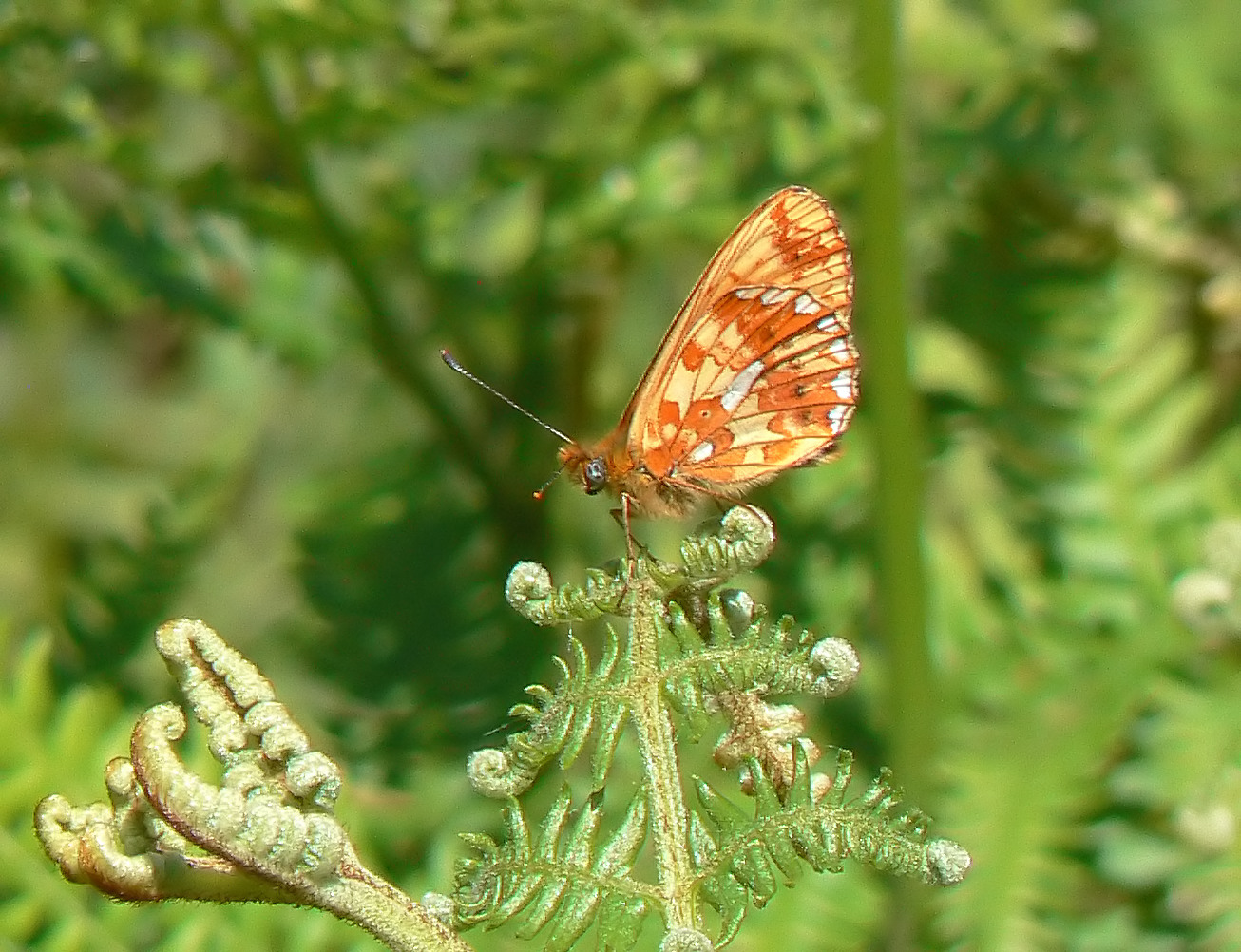
Silent Spring II (added May 2012)
I was saying last week that there is a lot of speculation currently doing the rounds to try to explain why this year is being a very bad year for our normal Spring migrants..... I've often thought that, when faced with a heap of baseless speculation, the best thing to do is to add your own to the pile - so here goes!
We definitely know that in 2011, we had breeding Whitethroats in the reserve, and that no Whitethroats have turned up in 2012, so what might be happening? Let's consider what might have happened to a new fledgeling Whitethroat from last year - I'll call him Rusty for ease of reference.
We do know that birds generally have a tendency towards site-faithfulness - probably due to the fact that they know their way back to where they came from, and also they know that they will be assured of suitable habitat when they get there, so there is a reasonable chance that Rusty would be headed back to the Lingfield Reserve to raise his own chicks. But he didn't make it - what might have happened?
Option 1. Not too sure about Whitethroats specifically, but small passerines only have an average life-span of 3-4 years, and mortality is disproportionately high in the early months, so there is probably an approximate 30-50% chance that poor Rusty didn't live long enough for future generations of Whitethroats to be even a consideration.
Option 2. Rusty lived out his first migration cycle and was heading back to the LNR, he reached the general area but then noticed that there is some superior habitat nearby (say Blindley Heath for example) which, unlike last year, is not already fully occupied by other Whitethroats. Numbers of most migrants are way down this year, so there's nothing to stop Rusty from jumping ship to a better 'des-res'.
Option 3. Similar to option 2, but instead of Blindley Heath, substitute Catalunya, the Dordogne or the Loire.... It's a long way north to come all the way to the UK and if you're not being forced to do so by peer-pressure, why not stay somewhere a bit closer to your winter territory?
Option 4. Birds are determined and not strong on self-pity so, even if faced with dreadful weather conditions, there is a possible scenario where birds, already weakened by journeys of thousands of miles, have simply battered themselves to death in the face of impossible climatic conditions in their determination to get back to the UK.
So... where does that leave the future of Whitethroats in the LNR?
In the case of Option 1 - this is merely business as usual... It sounds harsh but that's the way things are every year and the reason that most wildlife raises so many young. Many don't make it to be breeding adults themselves.
Option 2 is not so bad... Nature is quite resilient, and given no further problems, it is likely that Whitethroat numbers would increase again in years to come and we would end up with the species breeding in the reserve once again - not necessarily Rusty or his off-spring, but Whitethroats nonetheless.
Options 3 and 4 are a bit of a worry! If option 4 is happening on a significant level then obviously there will be a considerable crash in Whitethroat numbers in Western Europe and it may take some time to recover from this. In the case of Option 3, we would be looking at a general trend for birds to breed further south, and so yet more time for the species to recover to the UK in general and the LNR in particular.
Anyway... as I say, all baseless speculation - as far as I know there is no conclusive data as of yet upon which to base any reliable science; hopefully more information will come out over the next year, as I'm sure that there will be much examination of what has happened in 2012, which I believe to be an unprecedented year for avian migration in our lifetimes.
Of even more interest will be what will happen in 2013 - nature has a way of fighting back, so we may be pleasantly surprised.
Silent Spring (added May 2012)
Why do birds sing? (I hear you ask) ...Well, they sing for any number of reasons - sometimes just out of sheer exuberance it seems - but the major reasons are to do with breeding; specifically to establish and hold a territory and to attract a mate.
Breeding birds around these parts come in 2 flavours: those (such as Robins, Wrens, Blackbirds, Blue Tits) which are resident in the UK all-year-round, and those (such as Blackcaps, Whitethroats, Willow Warblers, Swallows, Nightingales, Cuckoos etc) which spend much of the year in warmer places and only migrate into the UK in the Spring-time for the breeding season. It is the influx of this latter group in late April/early May which form the spectacular dawn chorus that is the peak of the birdsong year.
Unfortunately, this year, it's all gone wrong!
Now you might think, in this age of communication and technology, where interest in birds has never been higher, that we would be able to understand exactly why our normal Spring migrants have failed to appear, but sadly that is not the case, and the best we have is a load of plausible-sounding, but none-the-less speculative theories, mainly pertaining to unfavourable weather systems in SW Europe. The situation is not straightforward to understand with different groups of migrants behaving in different ways.... Some such as Chiffchaffs and (to a lesser extent) Blackcaps are very early arrivers, and they seemed to get here OK in late March and very early April. A second group, such as Lesser Whitethroats and Swifts, have arrived on time and in reasonable numbers, and a theory is that they have either taken a different migration route or method, which has allowed them to pass through relatively unaffected (LWs come through eastern Europe, and Swifts are probably such powerful fliers, at such height, that it would take more than a bit of wind and rain to put off a Swift!). It is the 3rd group, which contains most of the Warblers, as well as Nightingales, Swallows, Martins, Cuckoos etc, which seem to be most affected, with birds arriving weeks late and in tiny numbers (so far at any rate)
What happens when bird numbers fall is that they 'contract back to prime habitat', which is a fancy way of saying that they will tend to go to the best places - not very surprising.... and so whilst it is still possible to find small numbers of most species out in the general countryside, the Lingfield Reserve (due to the levels of human/canine disturbance) will never be considered to be prime habitat.
Where does this leave the dawn chorus? Well, the best way to think of the 'normal' dawn chorus is like a concert orchestra, with many species all taking up the song in turn and on cue and coming together to form a crescendo of noise which is truly spectacular. What we have at the moment is a few Blackbirds and Robins (which would already have raised their first broods - UK resident birds breed earlier) singing desultorily for about 10mins before falling silent.
We were to have had a dawn chorus walk in the reserve, but I cancelled it.... To have gone ahead would have been a bit like paying for tickets for the Royal Philharmonic Orchestra, but getting there and finding that they have been caught in traffic and the promotor had booked Chas & Dave as a substitute!!
New Footpaths and Upgrades (added April 2012)
We are very pleased and grateful to have been in receipt of a grant from the Surrey Hills Leader project, which has allowed us to add a new section of surfaced footpath, leading around to the new seat at the top of Beacon Field and linking up with existing paths from the allotment area and also via the field shelter to Jenner's Field. We have also been able to upgrade some of the existing pathways and to include a turning circle at the end of the path to the new seat.
This whole project significantly increases the areas of the reserve which are now accessable to all.
The Rural Development Programme for England (RDPE) is funded by Defra and the EU. The European Agricultural Fund for Rural Development (EAFRD): Europe investing in rural areas
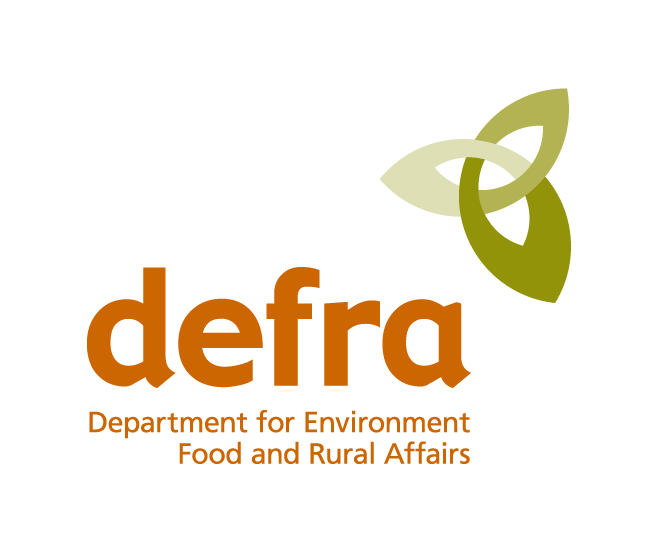
Annual Wildflowers (added April 2012)
You may have noticed 3 'flower beds' that have appeared alongside the path down through Jenner's Field - these patches have been rotovated and sown with annual wildflower seed mixes in an attempt to create some good habitat for the bees and other insects, as well as to create a pleasant spectacle for passers-by.
This is our first attempt to undertake such a project, so we are very much learning as we go along, with the biggest concern being that the vigorously growing plants which normally occupy that strip (coarse grasses, nettles, bracken etc) will recover from the rotovation and re-establish themselves before the more delicate annual wildflowers have a chance to germinate and get going themselves.
Fingers crossed anyway, as (if it works!) we should get a spectacular display during the late Spring and Summer months.
It is also the case that many species of bees and other pollinating insects are in decline, so we are trying to do our bit to create a small oasis of mainly UK annual wildflowers that will provide a valuable source of nectar and pollen for them; plus we would also hope to increase our population of butterflies and their visibility in a high-profile area right next to the main path through the reserve, where they can be easily enjoyed by the maximum number of people.
Pond Dipping 1st April (added April 2012)
Today was our first pond-dipping session of the 2012 season and it was very well attended, with approx 30 adults and 30 children coming along and giving it a go - air temperature was a bit chilly, but it was pleasant enough in the Spring sunshine.
Both ponds were quite productive in terms of our 'catch' - we want to keep activities in both ponds separate, in order to prevent cross-contamination of flora and fauna between the 2 habitats... In particular, we have some non-native, invasive plants in the upper pond, which we are trying to prevent getting established in the main pond if at all possible.
Highlights of the catch were: 6 Great Crested Newts, 9 Smooth Newts, numerous Damselfly larvae, 2 Dragonfly larvae, some diving Beetles and a Water-spider, which none of us could recall ever seeing before. There are some photographs on the gallery - people in the Activities gallery and the creatures in the Pond Life gallery.
This was our first pond-dipping session for which we are going to record the results, and it will be interesting to monitor how the 'catch' changes throughout the year, as different species are found in the pond, and also from year-to-year, as we try to monitor the success or otherwise of our management strategy for the habitat. Results will be accummulated in the Surveys page in due course.
We were particularly pleased that the newly-dredged main pond was quite productive and yielded lots of good results - all of the Great Crest Newts that were caught came from this pond, so they obviously don't mind the rather murky water.
All in all, a good morning!
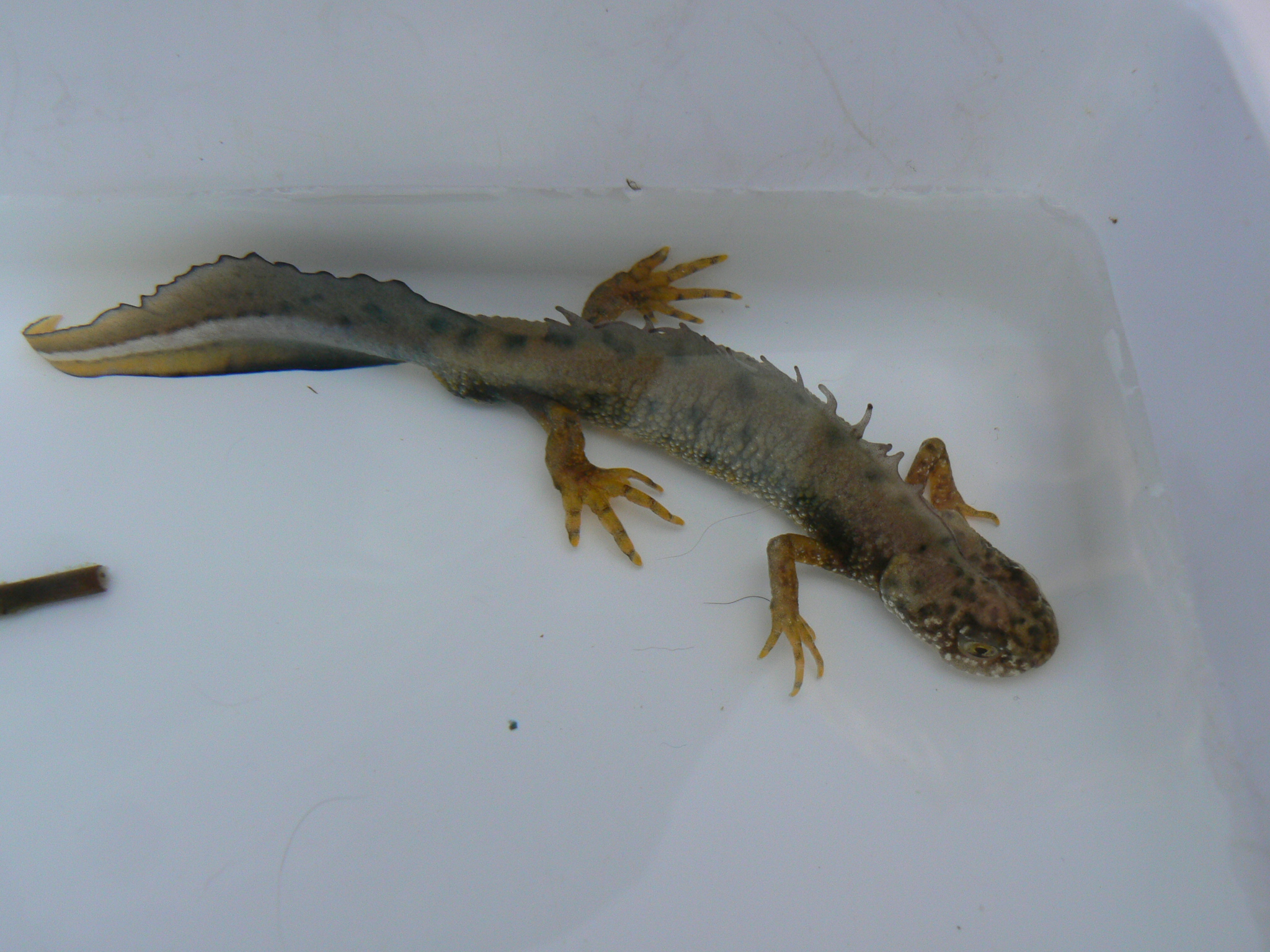
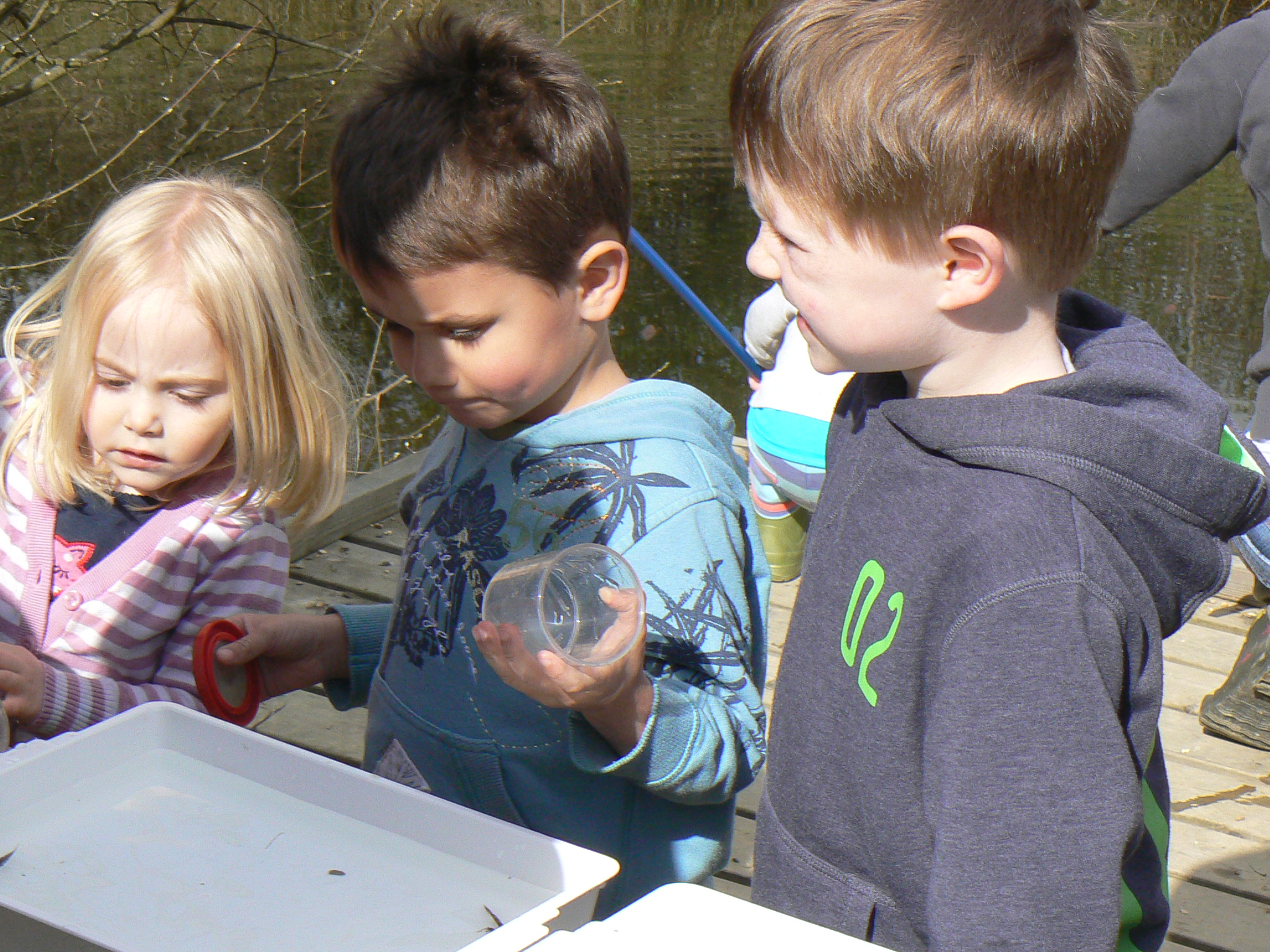
Pond Matters (added March 2012)
Not so much any significant news - more a round-up of many interesting things that have happened/will be happening in the pond area....
There have been quite a few new construction initiatives: As has been written previously, we dredged out the main pond last September and it is probably just as well that we did, as I imagine that it would probably be pretty dry by now, given the lack of rain. As it is, we've got almost a metre of water-depth (dropped a couple of cm in recent weeks) so plenty of water for the first pond-dipping session of the season which is scheduled for April 1st 10:00am. We have also constructed a stile and already far more people and families have been visiting the pond, which is good. We have also lowered a section of the wooden dipping platform (bit over-optimistic as rgds water-depth when this was first constructed) and created an earthen platform beside it so that we can accommodate more pond-dippers together.
As mentioned, the first pond-dipping session is on April 1st, and we also plan to start recording details of what we catch and also to commence weekly surveys of the dragonflies in the pond area. By the end of the summer, we hope to have gathered a good baseline of data for both of these species groups which will offer guidance to us when we formulate our future management strategy for the pond area.
Despite the cloudy water in the main pond, it is possible to see plenty of wildlife in both ponds, including Smooth Newts and our flagship species, Great Crested Newts, which are a threatened species, so it is very pleasing that we host a sizable colony of these. Now that the weather has warmed up a bit, I have also been noticing some ground-burrowing bees which has colonised the sunny clay banks around the pond - I don't know much about bees, but will try to find out what they are, as they look interesting!
New Pond Stile (added Feb 2012)
At the end of the month we will be installing a new stile across the fence surrounding the ponds. The intention is to make the ponds more accessible for anyone interested in exploring them while preventing dogs from getting into the enclosure. Installing the stile attracted some debate on the Reserves Management Committee. We are very conscious the Reserves are an amenity for everyone. At the same time they are primarily for wildlife which is often very sensitive to disturbance. When the ponds were completely open the banks were severely eroded by water loving dogs playing in the shallows every day. Many experts also warn against dogs in wildlife ponds as they can pollute the water and it is not known what effect their worming and anti flea treatments have on pondlife. So there were many pros and cons to consider and the debate was lively. In the end we thought it was best to open the ponds. Hopefully everyone will now enjoy them while respecting and caring for the wildlife and vegetation which now thrives in the ponds and their surrounds.
Halfway Finished!!
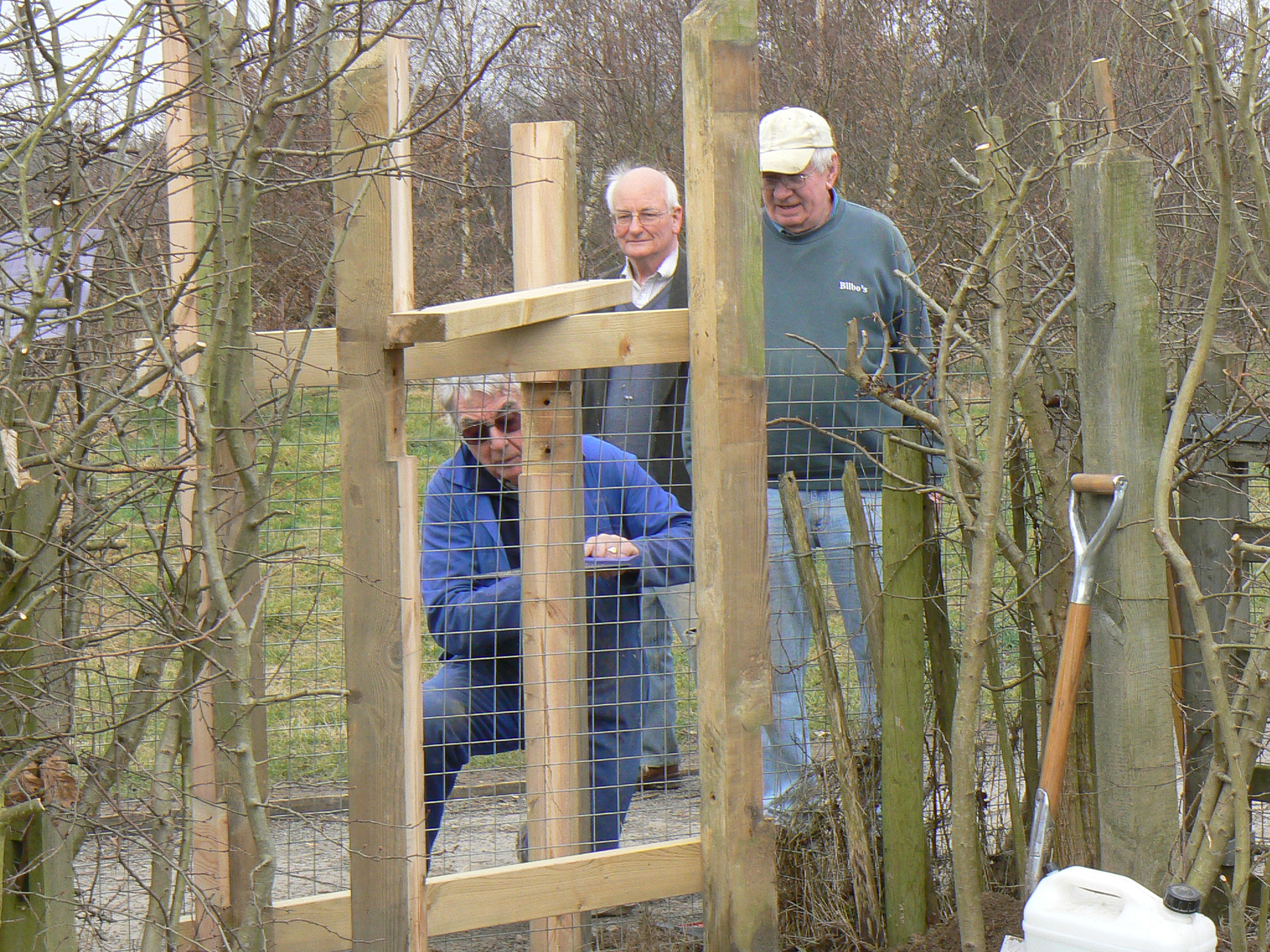
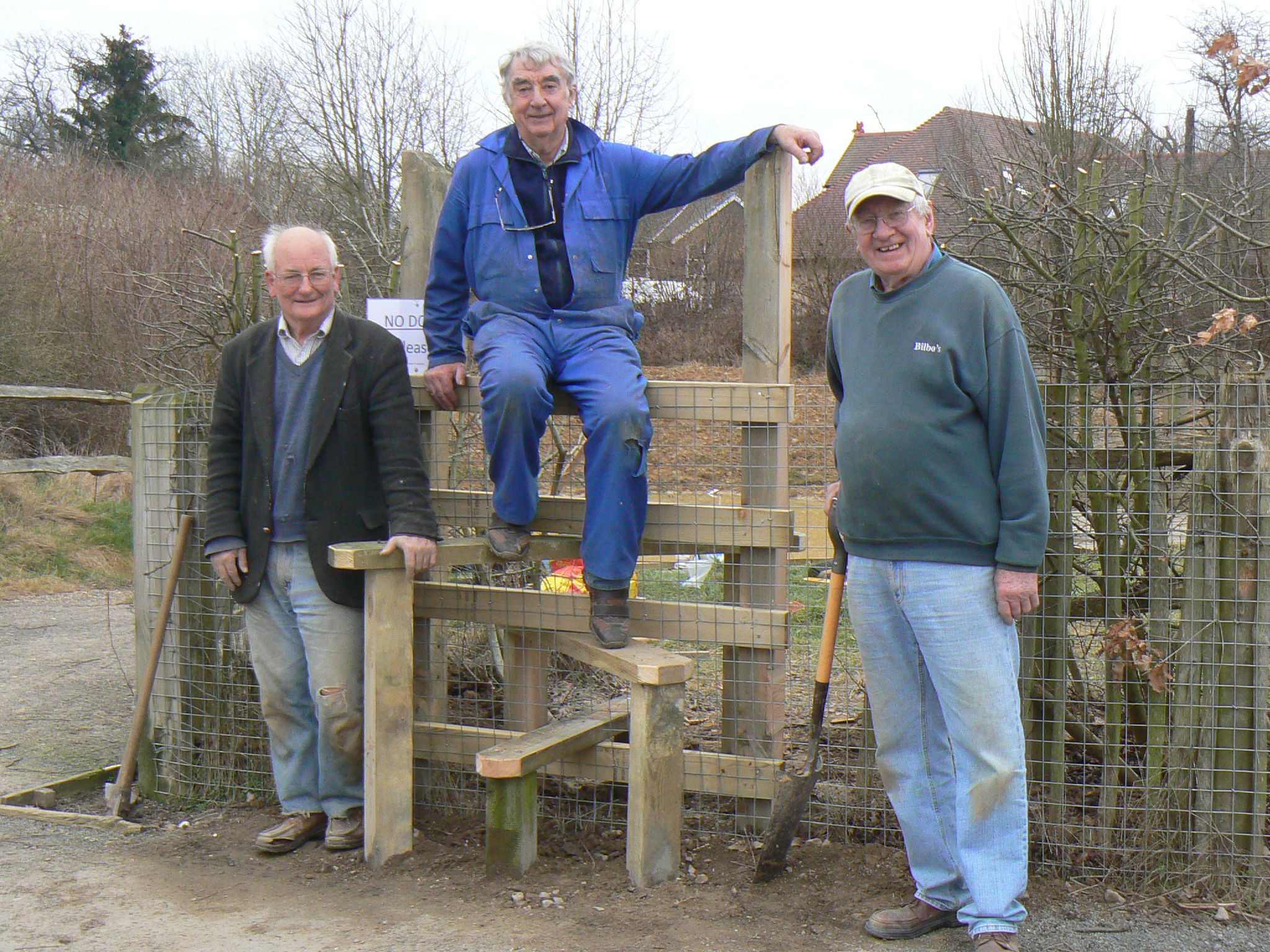
Work Party 27th February 2012 (Added Feb 2012)
Our regular work party this month was blessed with a warm sunny day. The main task was to continue the work of creating more structure within Coldharbour Copse. Before this work started the copse was very crowded with closely packed trees all of the same age. This was a result of nearly all the original planted trees surviving rather than a percentage dying. The intention of the management is to thin the trees to allow the most vigorous to grow taller leading to more variation in tree height. At the same time we have cut some trees down to ground level to allow more light to the copse floor to encourage the native woodland flower seed which we have scattered throughout to germinate and establish. Hopefully most of the stumps will send out shoots creating low level growth to create new habitat for nesting birds such as chiffchaffs and blackcaps which are common elsewhere in the reserves.
In addition, the trimming of the hedges round the ponds was completed to keep them from over-growing the path and allowing views across the ponds. Finally, the hay piles resulting from clearing the vegetation along the new ditch and around the ponds were cleared away. This work is to shorten the sward and encourage the wildflowers to establish and spread. As important, the hay was removed to avoid it rotting down and adding fertility which will benefit the coarse grasses at the expense of wild flowers.
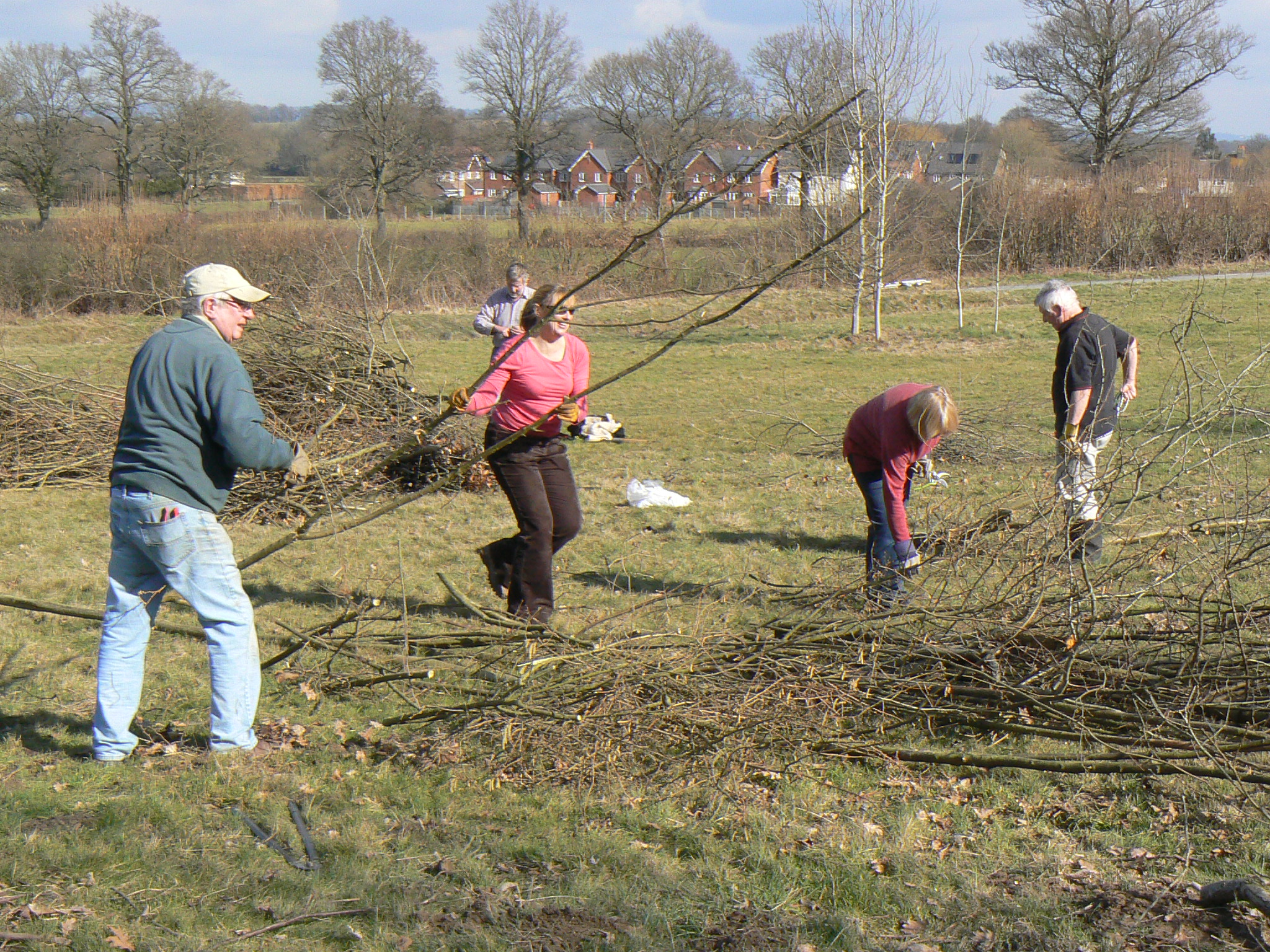
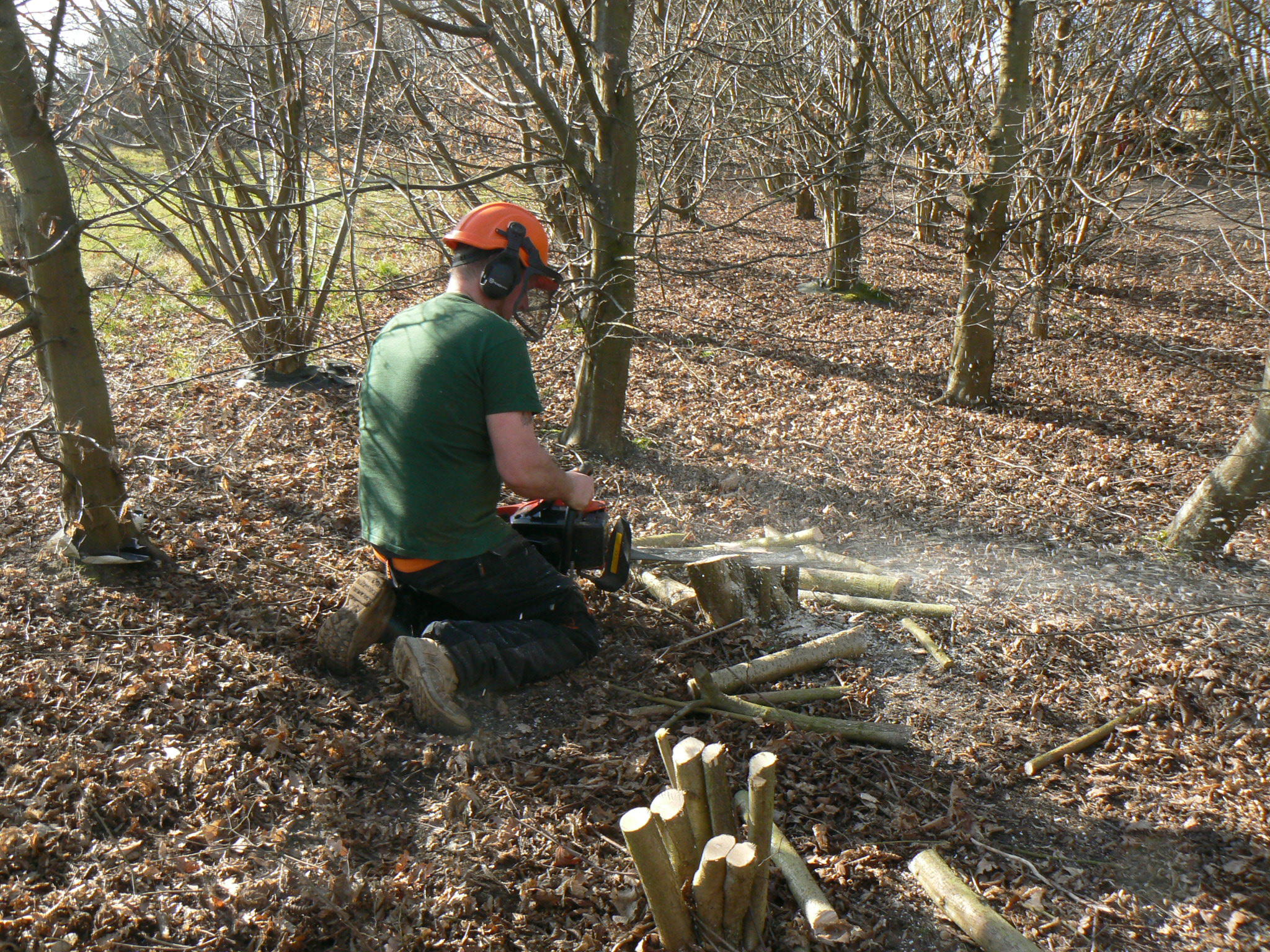
2011 Survey Highlights (added Feb 2012)
We now have the results of our butterfly surveys for 2011. It was good year with the second highest total of insects counted so far although average in terms of insect recorded per visit. The highlights were a Brown Argus recorded for the first time and Ringlet having their highest ever total. Common Blue and Holly Blue had good years. Gatekeeper numbers continued their improvement after several poor years. Off transect, the new ditch near Coldharbour again proved attractive for Small Skipper, Small Copper and Common Blue. Perhaps the most exciting development was the recording of a second new butterfly species, the Dingy Skipper. It and the Brown Argus were seen on many occasions in the new ditch favouring the bare sun baked earth at the bottom for basking. As usual, Speckled Wood were the most reliable butterfly, seen every week of the season and throughout the reserves. The numbers of several species were low or not seen on transect including Small Skipper, Orange Tip and Small Tortoiseshell. Overall 5 species increased, 7 were unchanged and 9 decreased.
Survey results of breeding birds from 2011 are broadly in line with previous years, with notable successes including Bullfinch, Garden Warbler and Long-tailed Tit. There were 5 previously unrecorded species in the reserve, the latest of which was Ring-necked Parakeets which were seen on several occasions in the autumn. This species is quite widespread in the south-east generally but have not been seen very often in the immediate local area – if their success elsewhere is repeated, then they are sure to become a common sight (and sound!) as they make their way noisily around the village and reserve.
For full survey results, see the SURVEYS item on the main menu
Brown Argus Ring-necked Parakeet
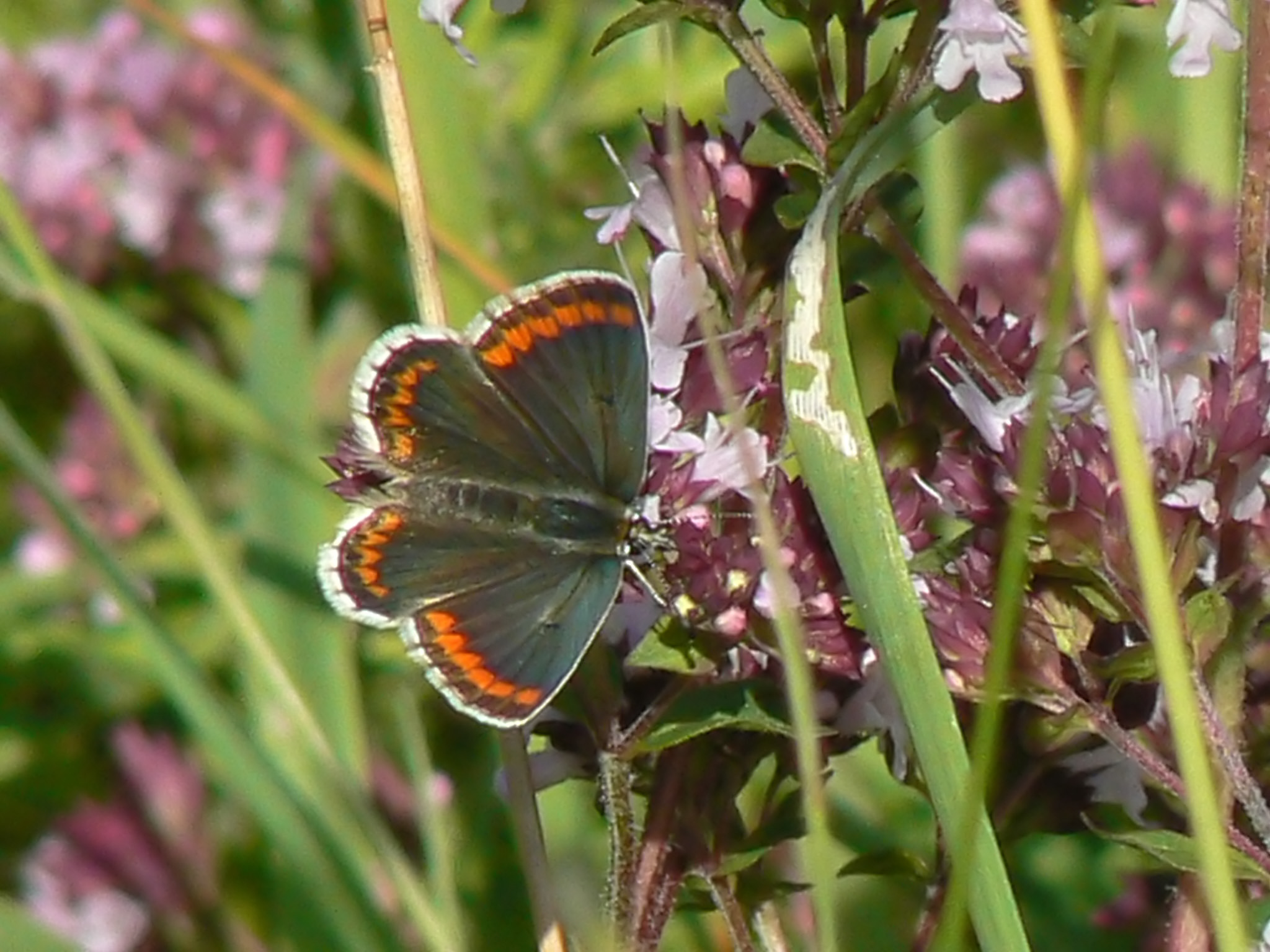
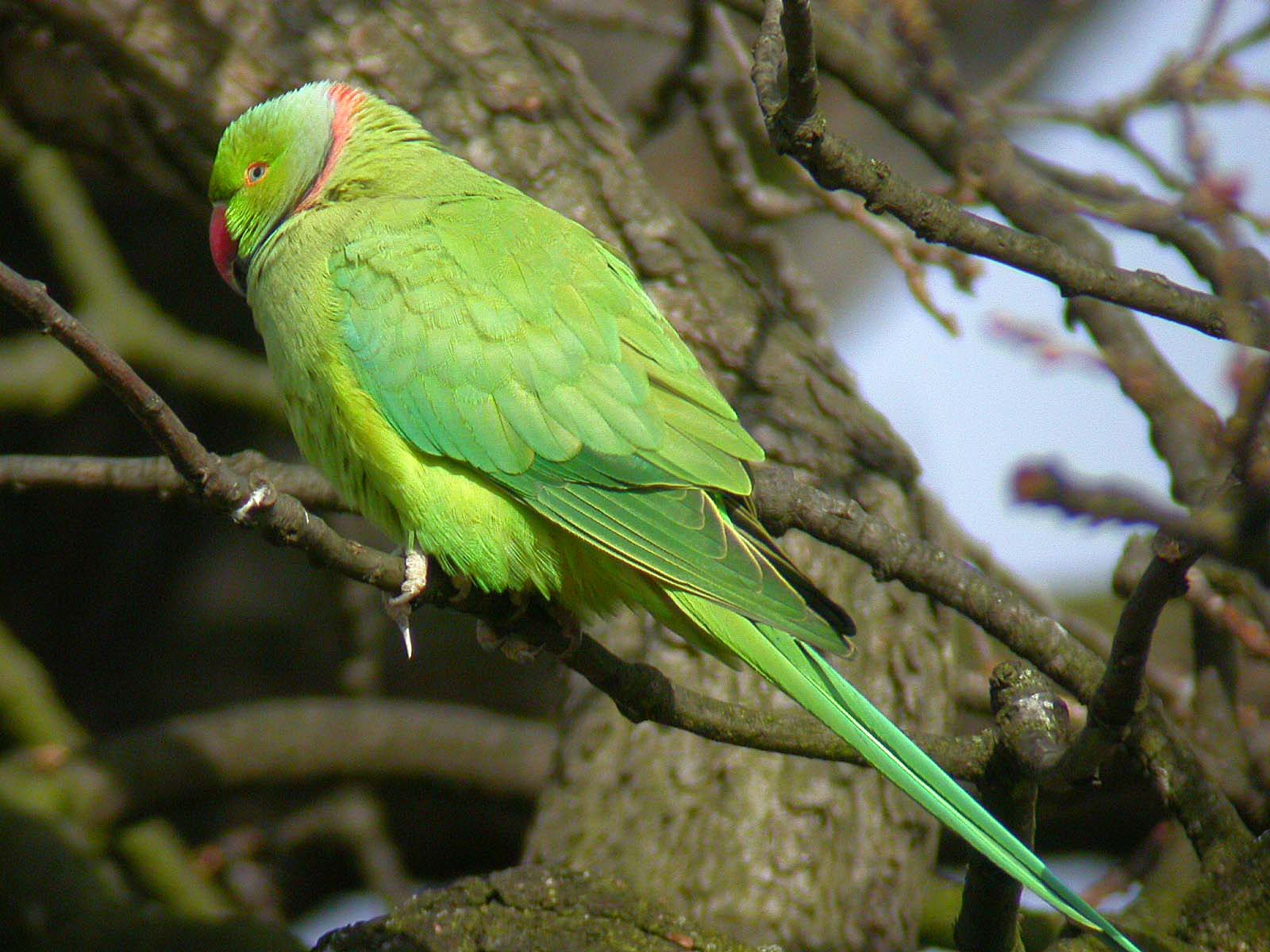
Coppicing Programme (added Feb 2012)
When Coldharbour Copse was first planted, the saplings were spaced quite closely together in anticipation of some failures, but in reality, virtually everything that was planted has still survived, which has resulted in some over-crowding.
It’s an ill wind though, as this gives us the opportunity to create some coppice. This involves cutting some trees back to the ground level or even shoulder height (pollards), allowing light down to the ground in Spring and Summer and encouraging woodland flowers and butterflies.
As the new growth becomes established, a dense thicket is created which will create more nesting opportunities for birds found on the reserves such as Chiffchaffs, Blackcaps, Garden Warblers and maybe even Nightingales. Just as important is to leave some trees untouched to grow as standards. Without competition they should grow into taller, larger trees creating more variety of structure in the woodland. The first part of the operation took place as part of the National Tree Week activities in November, and if this works well, we may be creating some more clearings by rotation in subsequent years. Initially, to many, it looks brutal and destructive but it actually encourages growth and biodiversity. Once some extra light is allowed down to ground level, we will be sowing some woodland flower seeds, and we are confident you will see the value as bluebells, primroses and violets establish.
Pond Improvements (added Feb 2012)
Possibly due to the presence of some old land drains, we have perennially suffered with low water levels in the main pond, and whilst it is the case that fluctuating water levels have a positive impact on wildlife diversity, the extremely dry Spring in 2011, and infill of silt and plant growth has meant that we were in danger of the pond disappearing altogether. Accordingly, it was necessary to carry out some dredging work to clear out some of this infill and to re-establish a clay base to the pond in an effort to improve water retention. Hopefully this will help to keep the facility available for the very popular pond-dipping sessions in the future.
This work is now complete and early indications are that the water retention is much improved - it hasn't been a particularly wet Autumn and Winter so far but already we have water to a depth of approximately 1metre and little sign of it draining away during dry periods. Of course, the acid test will come when we have extended periods of dry and warm weather later in the year.
Another useful by-product of the works is that we have some new clay-banks around the pond which should make for an good habitat for new plant-life and we have already sown several mixtures of waterside plants which are showing signs of germination, so an interesting time in store, as we wait to see what will develop in this new habitat.

